When Atari 50: The Anniversary Collection was released a few years ago, we thought that the compilation was good overall. The historical, full video interviews and peeks at other significant pieces of media were excellent, even if the focus was more on the Atari 2600 and less on every other era of the company's console history. The collection of games was good but lacked some titles from older compilations. Since then, Atari and Digital Eclipse have kept plugging away at the collection with a combination of free updates and paid DLC, making the package so much better that our initial score of the original compilation feels rather low. Three years later, and the companies are still adding on to the compilation with their latest DLC package, The Namco Legendary Pack.
It may seem like an unusual move to highlight Namco in an Atari compilation, but there's a very good reason for it. According to the historical documents, Atari helped kickstart Namco's entry into the video game business by selling its Japanese division to Namco, since Atari was facing an uphill battle in establishing its own company in Japan. Namco published Atari's arcade games in Japan and, in turn, Atari would later publish several of Namco's arcade hits in North America. The relationship would last until around the Atari 7800 era, but when you consider the titles that would come out from Namco at that time, it makes sense to highlight that part of Atari's history.
Like the main game and the DLC that was released afterward, this package is split fairly evenly between historical interactive documentary and the games themselves. The documentary portion comes with its usual mix of video interviews, archival pictures, and notable quotes that cover the time period. Things start off with some history about how Namco started, but there's more of a focus on Atari's side of the relationship, with anecdotes on how it was Breakout, not Pong, that gave both companies their first taste of video game success in Japan. From there, you'll get a few cool things, such as the movie theater commercial that played for the arcade release of Dig Dug, but the majority of this section focuses on the home release side of things.
Of the games specifically covered in this title, Pac-Man gets the bulk of the discussion, and that's understandable since that title ultimately sold around 11 million copies across all of the Atari platforms and was a genuine phenomenon at the time. You'll see print ads hyping up the home release. You'll get extensive interviews with Tod Frye, the man tasked with porting Pac-Man to the Atari 2600, and some insight on the decisions made with that port that are made fun of now but seemed OK when the game was initially released. For those interested specifically in this part of Pac-Man's history, it's fascinating, but there's still some room to briefly explore other Namco ports for Atari consoles, such as the story of how Galaxian was something of a miracle port for the Atari 2600, since it did things that were thought to be impossible on the console. Xevious for the Atari 2600 really was an impossible port, since the system was too underpowered, despite using many tricks to try and get things running.
When it comes to the games, there are only five titles featured in the Namco Legendary Pack DLC, but as with the rest of the compilation, you'll get multiple versions of each game. You can compare and contrast them and see how each new platform gave the games a chance to get as close to being arcade-perfect as possible. There are only two actual arcade versions featured with Dig Dug and Xevious, which may seem unusual until you realize that both of those titles were distributed by Atari's arcade division, while the other games had their arcade versions distributed by Midway.
Pac-Man has three versions represented here with the highlight being the Atari 2600 version. Despite whatever gripes people may have had with it over the years, this version of the game actually plays rather well when you come to grips with the limitations present on the platform. The rectangular dots seem odd but it also means that there are less to eat in order to complete a level. The flickering on the ghosts have a bit of charm to it though the lack of distinct colors per ghost is still a shame. The enemy AI remains aggressive and the game is still fun despite being an obvious downgrade over the arcade original.
Move on to the Atari 800 version, and most of the complaints of the Atari 2600 version have been addressed. All of the correct colors are back, the dots are actually dots, and fruit looks like fruit. The sound effects are also much closer to the arcade version, even though they aren't exact. Playing this version over the arcade version means dealing with a more horizontal maze rather than a vertical one so you will need to master the different layout even if you're intimately familiar with the arcade version's more vertical maze. One flaw with this iteration is the fact that the ghosts actually move slower and are less intelligent, so you can't easily bait them into following you when you're close to a power pellet to chomp them for a quick point bonus. The Atari 5200 becomes the best of the three home versions available in this compilation, as it adopts everything from the Atari 800 PC version while fixing the ghost AI and speed as well as bringing back the short cut scenes from the arcade game.
Galaxian is next on the list. Both the Atari 5200 and Atari 800 versions of the game are available, but you'll be hard-pressed to find the differences. However, the differences in the Atari 2600 version, which was released a year later, are more obvious. The playfield is smaller, the speed is a little slower, your ship is bigger, and there are only a handful of fewer enemies than in the other versions. Still, this is a very technically impressive port and most likely the version you'll end up playing the most.
Dig Dug is the next game in the compilation, and there are four home versions represented. The Atari 2600 version plays fine, but you can see that the game pushes the hardware significantly with missing animations and fairly laughable inflation states for each enemy. While it's graphically better, the Atari 800 version plays a little worse because the game seems to have issues detecting when your pump line actually reaches an enemy to start the inflation stage. By contrast, the Atari 5200 version looks a little worse, but the gameplay is more responsive. It seemed like Atari itself recognized how good it was, since the Atari 5200 version eventually replaced the original Atari 800 version on that platform. Then there's the Atari 7800 version, which got all of the colors right and finally let you dispatch the pump through thin layers of earth, but it looked chunkier than all of the other versions before it.
Galaga is represented by the Atari 7800 version. This is still a fun game, but the lack of power in the 7800 really hurts the game. The graphics look fine, but the sound effects are terrible to the point that you wish they would've just used the effects from the 5200 port of Galaxian instead.
Finally, there's Xevious, which is also represented with an Atari 7800 version. It's significant because this is the first home version of the game released in North America, with the NES version coming in several years later. Considering the limitations of the 7800, this version is pretty good. While the graphics may not be that great, the sound does a good job of matching the original arcade game. The only knock is that it looks like there may have been a prototype of the Atari 2600 lying around somewhere because you'll see snippets of it in the documentary section talking about Xevious, but it is a shame that the 2600 version isn't playable in this compilation.
Atari 50: The Anniversary Collection - The Namco Legendary Pack DLC marks an excellent addition to the base game. These are some classics for the Atari family of systems, and considering that Namco barely addresses these iterations, it is good to see them on modern platforms, warts and all. As usual, the documentary sections make this collection worthwhile, so if you're a retro enthusiast, be sure to snag this piece of DLC.
Score: 8.0/10
More articles about Atari 50: The Anniversary Celebration Expanded Edition











 Atari 50: The Anniversary Celebration Expanded Edition takes players on an interactive journey through Atari’s rich and colorful history through more than 140 classic games.
Atari 50: The Anniversary Celebration Expanded Edition takes players on an interactive journey through Atari’s rich and colorful history through more than 140 classic games.






